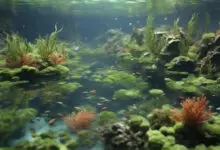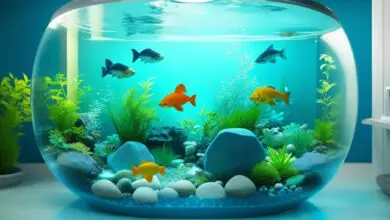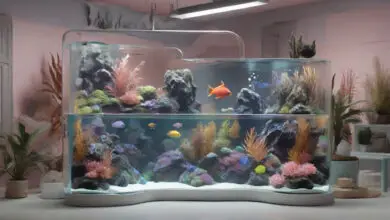Keeping Your Marine Tank Clean with a Sump System

Having a clean and healthy saltwater aquarium is important for both the fish and coral living in it. One key way to help maintain good water quality is to use a sump system. A sump is an extra tank that works together with the main display tank to filter and clean the water. Having an effective sump setup takes some planning and maintenance, but is well worth the effort for crystal clear water.
In this beginner’s guide, we’ll cover everything you need to know about sumps for marine tanks. We’ll look at what exactly a sump does, the different parts that make up a system, how to design and install one properly, and tips for keeping it running smoothly. With the right sump system and upkeep, you can easily control nutrients and keep pollutants out of your display tank.
What is a Sump Tank?
A sump is an additional aquarium that goes underneath or next to a main show tank. It works using gravity to pull dirty water from the display tank into the sump setup below where it gets cleaned. This cleaned water is then pumped back up into the main tank, creating a continuous loop.
The main purpose of a sump system is water filtration. All the various filtering elements housed in the sump work together to scrub the water clean for crystal clear quality. The additional water volume from the sump tank also helps dilute waste and nutrients to prevent build up.
Sumps also have other advantages:
- Provide more overall system water volume for dilution and stability
- Allow equipment to be hidden away for sleek displays
- Open up more space in the main tank for aquascaping and livestock
- Offer a place to hide heaters, protein skimmers and other gear
For marine tanks specifically, sumps help manage complex water chemistry much better than simple hang-on-back or canister filters. The customizable chambers allow targeting of every aspect for healthy saltwater.
Parts of a Saltwater Sump System
Sump systems are made up of a few key components that work together to both mechanically and biologically filter aquarium water. Understanding the role of each piece will help create an effective system:
Main Display Tank – This is the primary aquarium tank housing all the livestock and decorations. Water overflows from here into the sump.
Overflow Box – This box installed in the main tank connects to plumbing that gravity feeds water down into the sump. It prevents floods by limiting how much water can drain.
Return Pump – After getting cleaned in the sump, this pump moves water back up into the display tank, completing the loop.
Sump Tank – This secondary tank sits below the main one to receive and filter the water. Several chambers divide up the filtration types.
Protein Skimmer – This is one of the key filtration devices, mounted in one of the sump chambers. It helps remove dissolved organic waste from the water column.
Heaters – To properly regulate temperature, heaters are tucked away in a chamber to evenly distribute warmth.
Media Baskets – Specialized filter media like activated carbon and bio-balls provide mechanical and biological cleaning.
Plumbing – Flexible tubing carries water from the overflow to the sump and from the return pump back to the display aquarium.
Plumbing System Design Basics
One of the keys to a properly functioning sump system is how all the plumbing connects together. Failing to plan out the piping flow can lead to disasters down the road. Here are some basics to keep in mind:
Overflow Box Types
There are a few main types of overflow boxes used to transfer water from the main tank down to the sump:
Hanging – Hangs on the rim with notches to set water height
Internal – Installs fully inside the tank for a cleaner look
External – Mounts outside on the tank and uses bulkheads
Most overflow boxes feature teeth or slots that break up the water into smaller streams. This prevents flooding and allows air bubbles for proper siphon.
Drainage Plumbing
Drainage tubing leading from the overflow to the sump should be properly sized:
- Use 1” piping as a standard for tanks up to 125 gallons
- For larger systems, use 1.5” or 2” piping
- Avoid sharp bends or kinks that limit water flow
It’s also key to have the drainage line be one continuous piece without connections which could come apart. Secure it with clips designed for aquarium plumbing.
Return Pump Sizing
You want a strong enough return pump to push all the water back up to the main tank without struggling:
- Shoot for 4-5 times total system gallons per hour
- Use multiple lower capacity pumps instead of one large one for redundancy
- Install ball valves to control and split flow
Undersizing the return pump is one of the most common sump issues that causes problems.
Sump Tank Chambers and Filtration Types
Sump tanks are divided into separate chambers that each perform different filtration duties like mechanical, chemical, and biological. You can have as few as two chambers or more commonly three to five.
Here are the most typical sump chambers and what goes in each:
First Chamber – Mechanical Filtration
The initial chamber is for mechanical filtration, screening out solid debris before it reaches other areas. Here you would add:
- Sponge Filters – Traps suspended particles and break up water flow
- Filter Floss – POLISHES water by catching microscopic debris
- Sediment Traps – Collects falling sand and grit out of the water
Adding multiple types helps thoroughly cleanse the water before it moves on.
Second Chamber – Protein Skimming
One of the most important devices in saltwater filtration is mounted here – the protein skimmer. It’s a complex device that uses air bubbles to remove organic waste that feeds algae and bacteria.
For peak operation:
- Stick with reputable protein skimmer brands and properly size it
- Allow 6-12” before and after for foaming action
- Keep consistent water height right at skimmer cup drain line
This chamber may also contain media reactors if using products like GFO and carbon.
Third Chamber – Return Pump
Here is where the main return pump gets mounted to push cleaned water back up into the display aquarium. Be sure to:
- Install 6” above the floor for pump safety
- Camouflage intake to prevent trapping fish
- Use quick disconnects for easy pump removal
- Consider a secondary pump for redundancy
Optional Chambers
If space allows, you can add additional chambers for specialized roles:
- Heaters and Chillers – Stable temperatures
- Calcium Reactors – Maintain proper pH/alkalinity
- Refugiums – Grow beneficial macroalgae to export nutrients
The more chambers, the more aspects of water quality you can perfect.
Installing and Setting Up a Sump
Once you have all the parts chosen, it’s time for installation. Follow this process closely when setting up your sump system:
Sump Tank Placement
- Position the sump below or beside the main tank on a very sturdy, LEVEL stand
- Have it around 20% of main tank volume to allow for displacement
- Make sure it’s accessible for maintenance and adjustments
Overflow Plumbing
- Cut drainage tubing to correct length to prevent sagging or strain
- Secure tubing along its entire run – DO NOT allow any loose segments
- Double check bulkhead gaskets to prevent leakage
Sump Chambers
- Divide chambers using glass dividers or acrylic sheets sealed with aquarium-safe silicone
- Drill extra holes to allow adjustable water heights between chambers
- TEMPORARILY block pump return line until system tuned
Initial Fill and Test
- Partially fill the sump tank chambers and check for any leaks
- Cycle tank through an entire drain and refill loop
- CONFIRM proper flow rates and that nothing overflows
Make Adjustments
- Regulate baffles and water levels to optimize skimmer function
- Redirect or restrict flow for maximum exposure times
- Swap filter media placement for ideal mechanical/biological cleansing
Final Check and Power Up
- Verify quiet and smooth operation of return pump
- Make sure heaters safely heat up sump only a few degrees
- Power on and tune protein skimmer collection
- DOUBLE CHECK for leaks, blockages or other issues!
Take your time when first installing a sump system on an existing tank. Carefully check for any problems during every step before moving onto the next. Rushing generally leads to accidents and flooding.
Operating and Maintaining a Healthy Sump
Even a perfectly designed sump system will have problems if not properly maintained. Just like changing the oil in your car, regular cleaning and component replacement is vital. Here are some best practices:
Regular Maintenance
- Every month, clean filtration pads and chamber walls with tank water
- Rinse protein skimmer collection cup when full to prevent overflow
- Check and clean return pump impeller assembly if flow seems low
- Monitor media like activated carbon and replace as needed
Component Swaps
- Replace mechanical filter floss and pads about every 3 months
- Swap out carbon and phosphate media every 4-6 months
- Change return pump tubing annually for maximum flow
Water Changes
- At water change time, USE A GRADUAL SIPHON METHOD from the sump
- Never drain the sump completely – leave several inches to preserve bacteria
- Slowly refill if using RO/DI filters to avoid pH swings
Leak Checks
- Examine bulkheads, tubing and plumbing for any signs of leaks
- Confirm baffles are solidly sealed between chambers
- Check and retighten fittings if needed – DON’T overtighten!
Setting reminder alerts on your phone can help prompt you complete routine maintenance before small issues get out of hand.
Common Sump Problems and Solutions
Even when initially set up correctly, sumps can develop issues over time that degrade performance. Catching problems early makes them much easier to fix. Some common examples include:
Problem: Excess microbubbles in the display tank
Solution: Adjust the drain standpipe height or add a small piece of foam
Problem: Protein skimmer not producing thick dark skimmate
Solution: Ensure proper water height adjustment and that collection cup isn’t overfilling
Problem: Sump water level rising or overflowing
Solution: Clean return pump impeller assembly and check for plumbing blockages
Problem: Salt creep buildup covering chambers
Solution: Direct return pump output across the water’s surface to reduce splashing
Problem: Equipment constantly turning on and off
Solution: Buffer sump pump timers to avoid frequent power cycling
Don’t hesitate to ask questions online to experienced aquarists if you run into any trouble. Many issues can often be easily fixed with a few adjustments.
Conclusion
Having an efficient sump setup makes maintaining proper water quality much easier for marine tanks. While it adds initial complexity to plan and install, once up and running few pieces of equipment offer as many benefits. Just be sure to factor in extra maintenance tasks into your aquarium care routine.
If designed, built and operated correctly, sumps handle removing waste, managing nutrients, and filtering water so your livestock stay healthy for years to come. Start simple but don’t be afraid to expand chambers over time as your experience grows. Before long, you’ll have those crystal clear sparkling waters that reef tank dreams are made of!







